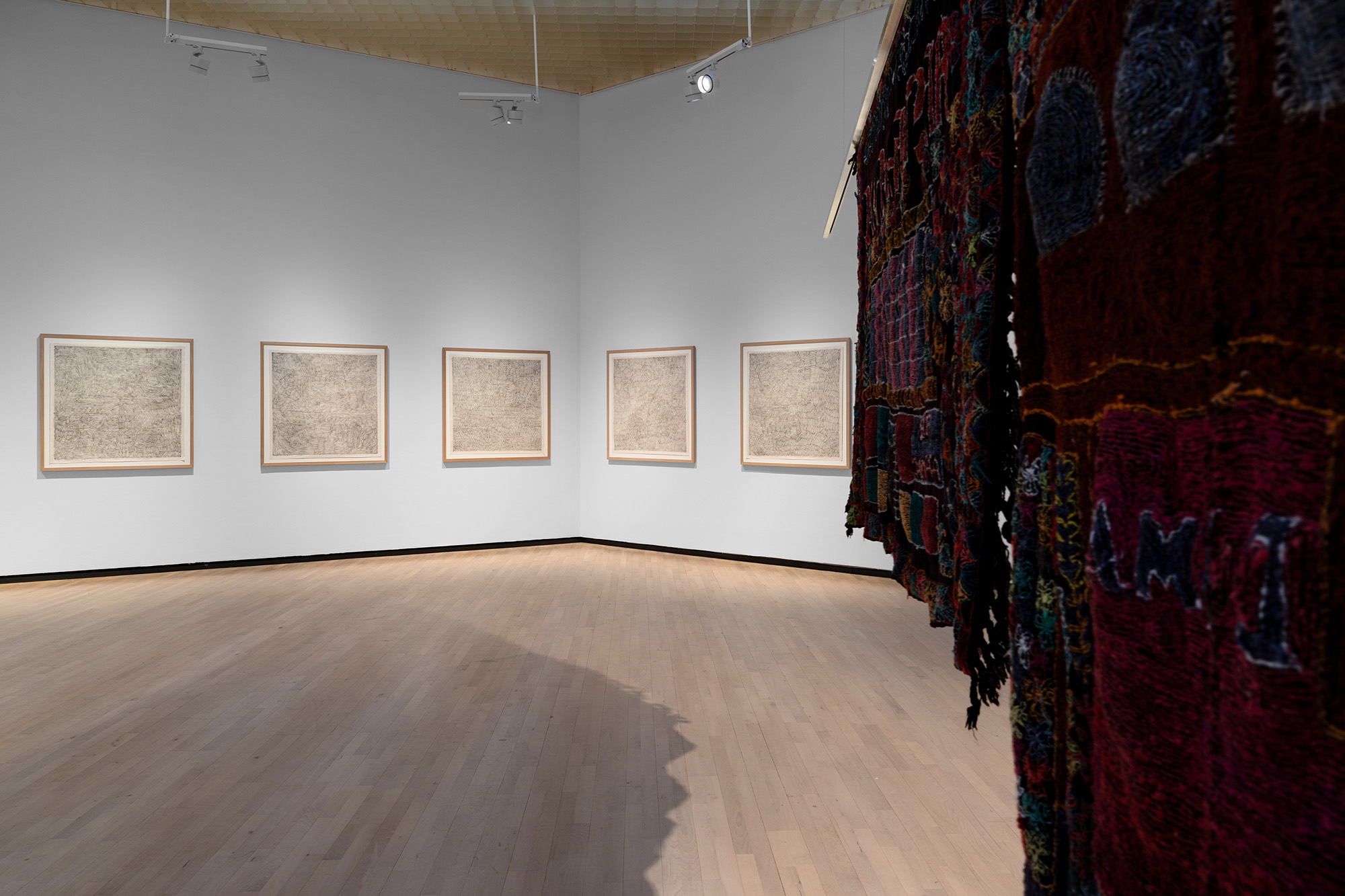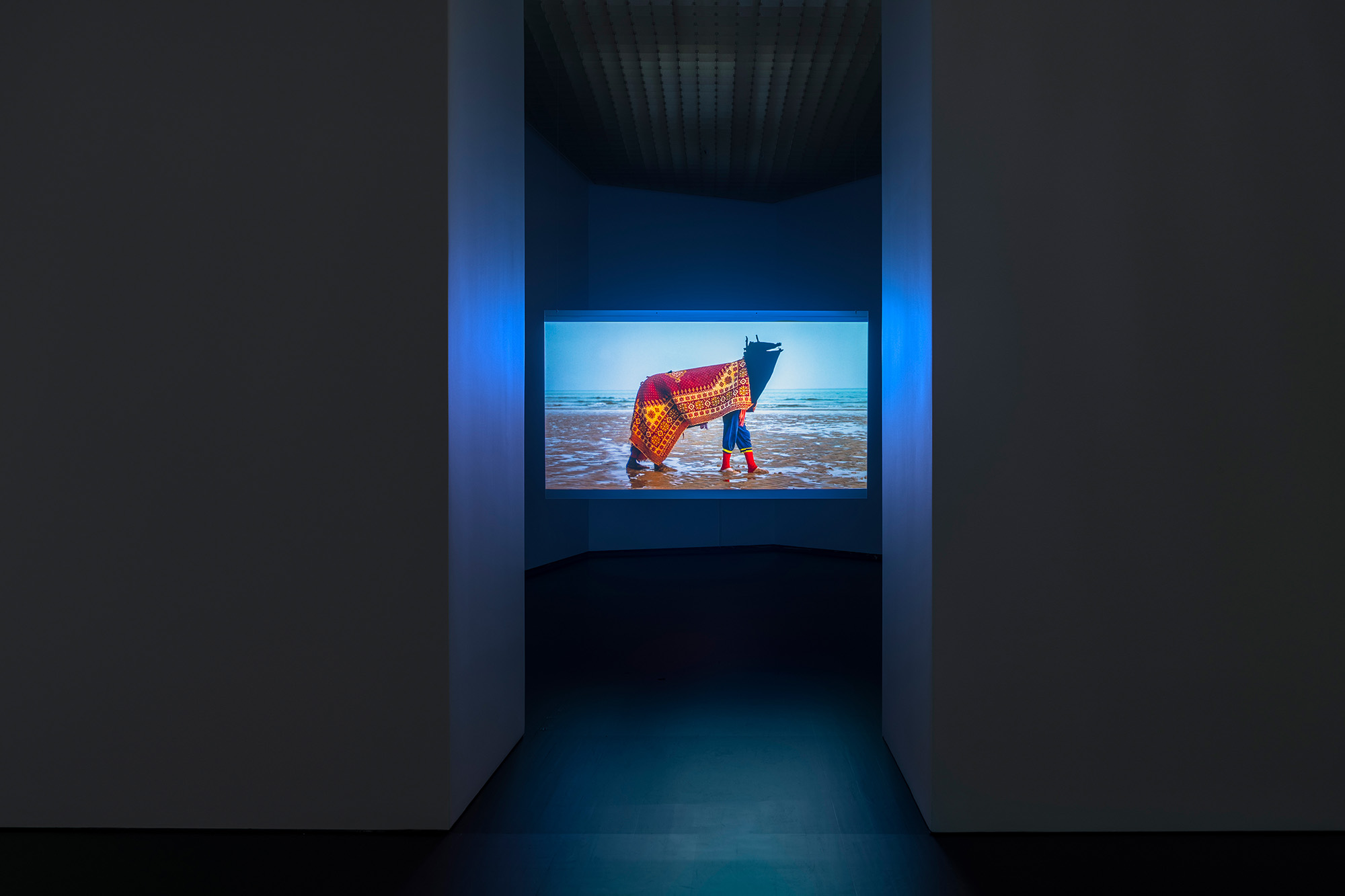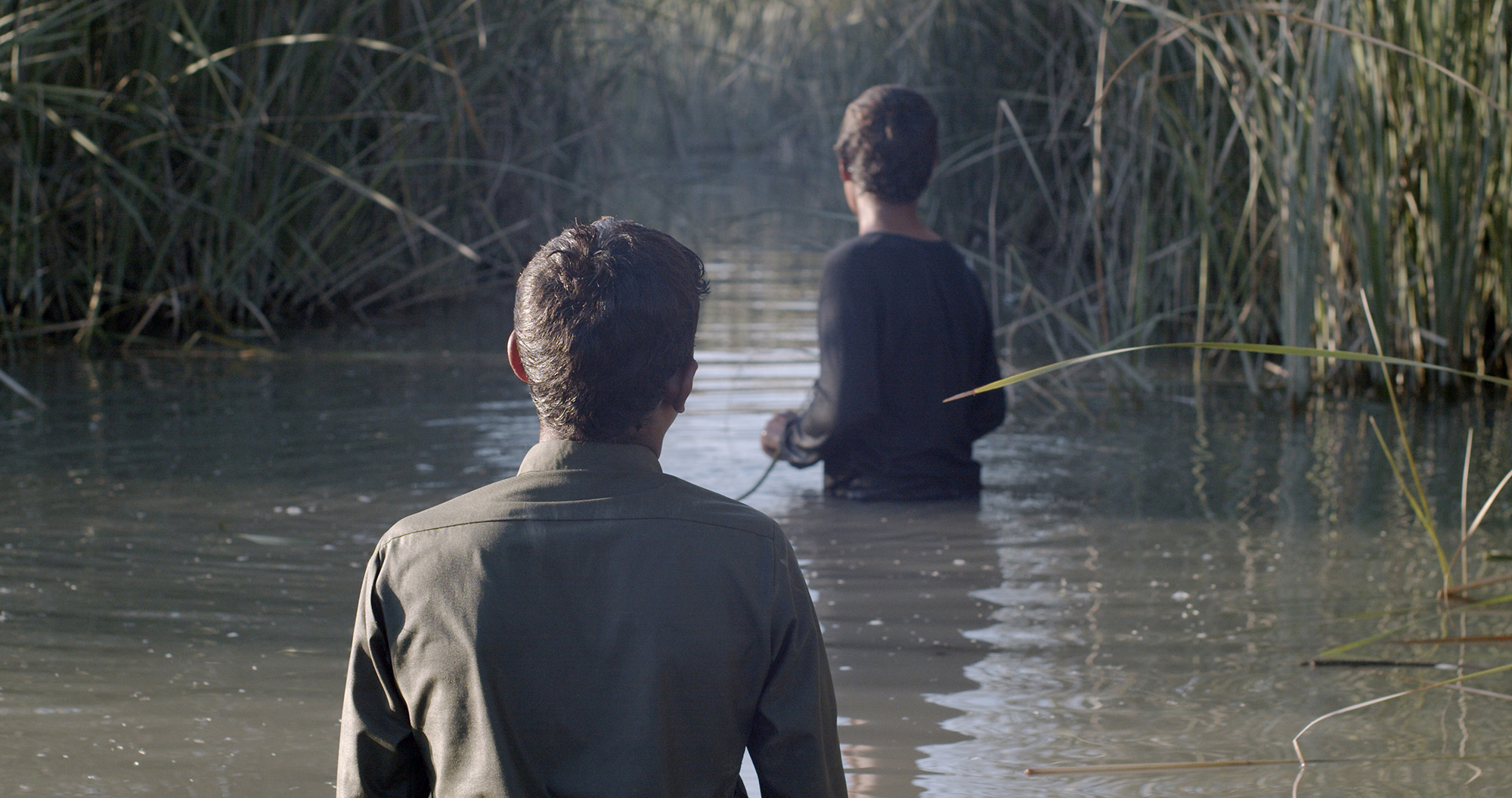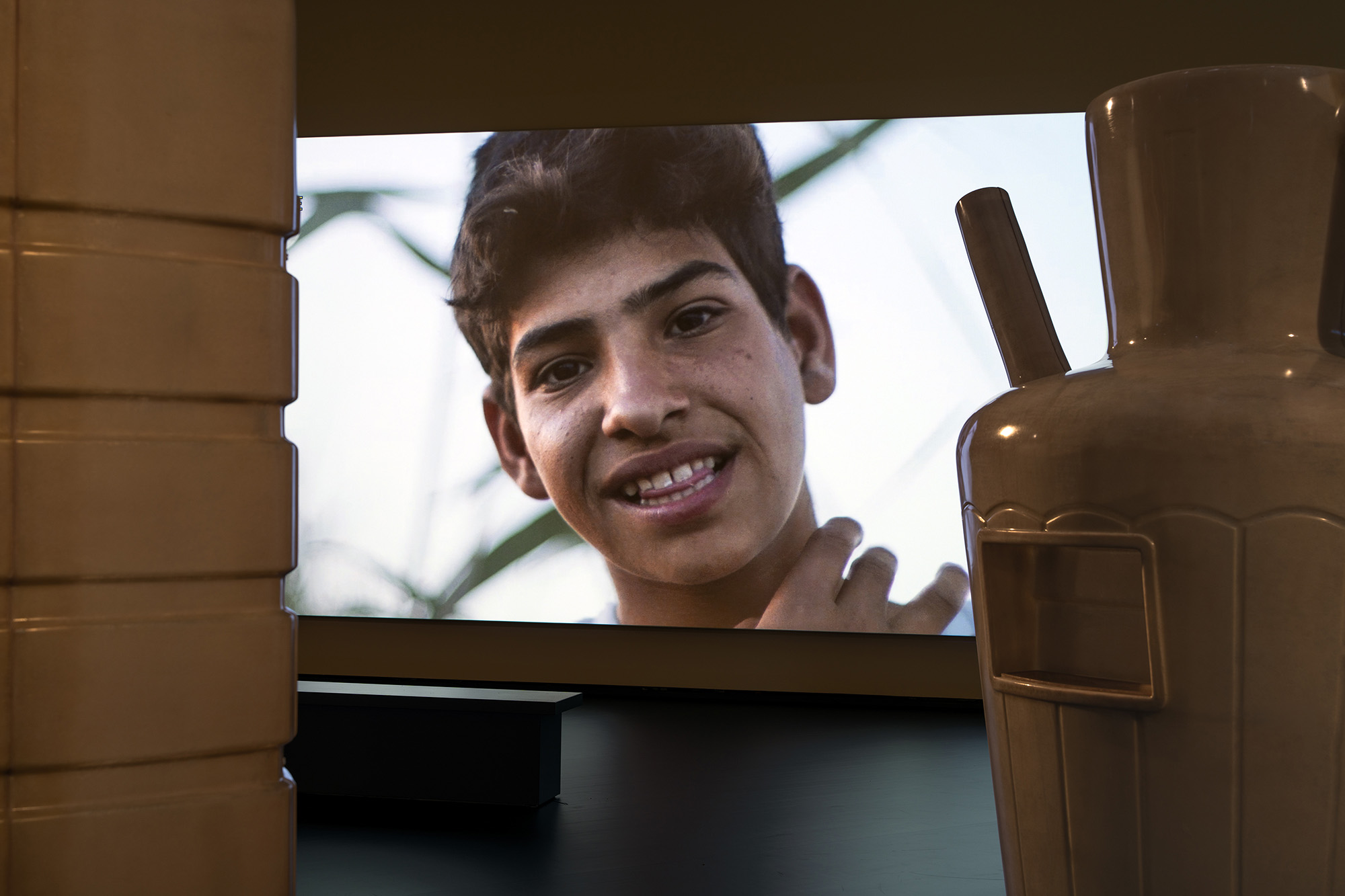An artist going places: Alia Farid at Oslo’s Henie Onstad
Kunstsenter
Kuwaiti-Puerto Rican artist Alia Farid mounts Bneid Al Gar, her largest solo exhibition to date, at the Henie Onstad Kunstsenter on the edges of Oslo, part of her prize as third recipient of the centre’s Lise Wilhelmsen Art Award. Jelena Sofronijevic visited the exhibition of textile, drawing, film & sculpture to find works dealing with trans-geographic relationships to land & place from an artist rising in international prominence.
Bneid al Gar may be Alia Farid’s first exhibition in the Nordics, but the artist is no stranger
to the region. Ten years ago, at the 2014 Venice Biennale of Architecture, Farid staged a sculptural intervention outside the
Nordic Pavilion. Their symbolic return of a gift of a water fountain, a feature
of tropical modernism exported to Kuwait, was also intended to make a
point about who receives temporary and permanent national representation at such
an international platform – and who can access fresh water, for free.
The Henie Onstad Kunstsenter, which juts above the still waters of the Oslofjord in Norway, might not seem a natural home for an artist who often confronts turbulence and violence in their work. Yet it is this interest in fluvial bodies – human and more – running through Farid‘s practice, that enables their works to gain new meanings in different local contexts.
![]()
![]()
In Lieu of What Is (2022) is amongst their most well-travelled works, inspired by public drinking fountains in the Arabian Gulf, and the aforementioned Venice Biennale intervention. This procession of plastic sculptures follows the ‘oil urbanisation’ of Kuwait’s capital which, from its first export in 1947, experienced rapid industrial development and transformed from mud to a modern city in just twenty years. It also navigates the flows of both oil and water between Kuwait and Iraq, two historically interconnected countries estranged by war, and the drawing up of artificial borders.
In the text that accompanied Farid’s presentation of In Lieu of What Is for the 2023 Artes Mundi 10 in Wales, environmental anthropologist Bridget Guarasci writes of “used to be” landscapes which have endured sustained environmental and economic extraction, concurrently with civil conflicts, throughout the 20th century. These artefacts seem like the findings of an archaeological dig, evocative of the Kuwaiti tradition of leaving out water vessels for travellers, a nod to the artist’s interests in time and history as something that also lives and moves.
![]()
![]()
This deeper concern with access is shared in Norway, another young country, where water quality serves as a source of pride and part of national identities. Installed on black vinyl flooring – one concession made within the conventional museum space – the medium and exaggerated scale of In Lieu of What Is suggests the great impact of state policies on everyday lived experience. Indeed, Farid is as critical of post-Saddam Hussein Iraqi governments as foreign powers, mutually complicit in their deals and in the construction of desalination plants in the ongoing marginalisation of the local majority. When discovering Farid’s work in Artes Mundi, Cardiff audiences also found common ground between the artist’s film representations of the bruises of black tar with slag heaps still present in former mining communities.
Bneid al Gar speaks as much to the conditions of its namesake – Farid‘s childhood home in Kuwait, which translates as “land of tar” – as the political landscape of contemporary art practice. As part of the Henie Onstad Kunstsenter-organised Lise Wilhelmsen Art Award, artists receive a survey exhibition, extensive catalogue, and collection acquisition. Previously awarded to Otobong Nkanga and Guadalupe Maravilla, the award also serves as a tool for building and sharing knowledge beyond the institution – something especially important for an artist long interested in architectures of education and learning.
![]()
![]()
Beyond the initial celebration, the generous award provides a pool of funding for Farid to realise planned projects. In the exhibition, a series of colourful handwoven and embroidered tapestries from the series Elsewhere (2023), a textile recreation of the streets of Puerto Rico's Palestinian diaspora, is the start of such plans. It is rare to experience social architectures and infrastructures through textiles, though homes – concrete or nomadic – are often constructed through the work of women. The artist describes these works as a “first chapter” and intends to expand their research into Trinidad and Tobago and Cuba, a mapping Arab and South Asian diasporic communities to detail transnational migrations across the Global South, and closer, transregional ones, between the Caribbean and South America.
Created in close collaboration with weavers in southern Iraq, Elsewhere explores the different expressions that can emerge from a single point of origin, as well as the forms and struggles shared between communities within the Global South and new meanings and solidarities made in the process of migration – indeed, Farid locates her “artistic upbringing” in the Caribbean, with her mother‘s “more creative” side of the family.
![]()
![]()
Convergence and divergence also characterise the display at Henie Onstad. When presented at London’s Chisenhale Gallery, the textiles were hung in parallel lines; here, they verge into a vanishing point. Elsewhere, Farid says she would like to have them stacked in piles as a tactile book for audiences to leaf through, perhaps a risk institutions would be reluctant to take. The Henie Onstad Kunstsenter hang is incidental to the lung-shaped gallery spaces, yet it speaks to the narrowing of human lives and possibilities in the year that has followed their Chisenhale presentation, which opened in aftermath of the October 7th attacks by Hamas. It is notable that their acquisition includes work inscribed “from the river to the sea” in Spanish, a call reinforced with chain stitching specific to the Arabic region of Samawa. Perhaps this narrowing or widening of perspectives is a matter of stance, of where we stand in Farid‘s streets.
These tapestries – as fibre artworks of a sort – will suit Henie Onsted’s regulars, and might connect with wider audiences familiar with this form of cultural expression. In the city centre district of Tøyen, home to Oslo’s largest migrant population, the Intercultural Museum is presenting Ndiakhass, an exhibition of six artists based in Senegal and Norway. Included are Ibrahima Thiam’s series of photographs of Senegalese ritual practices evokes images of animal masks, horse heads, and ritual dances along the waterfront, both a celebration and protestation of the loss of intergenerational knowledge that often results from environmental degradation. To a visitor experiencing both exhibitions, these images might carry poetic likeness to Farid’s film of fishermen’s festivals, At the Time of the Ebb (2019), documenting Iran’s Qeshm Island on the longest day of the year as local residents celebrate their natural surroundings through performance.
![]()
![]()
Another of Farid’s films on display, Chibayish (2022, 2023), will travel with the artist to London in November as they return as a finalist of Victoria & Albert Museum’s Jameel Prize 7. This edition, devoted to moving image and digital media inspired by Islamic art, culture, and history, takes an expansive, interdisciplinary approach, perhaps informed by curator Rachel Dedman’s particular interest in the social fabrics of Palestine. This works for Farid, an artist who is not medium-specific but interested in negative space: whether the topographical nature of their textiles, thinking “beyond the limits of the city”, or in the protection and reclamation of grounds often homogenised as empty deserts. Like In Lieu, their film works also address how ecosystems are targeted as a tactic of war; their audio from the marshes and along the shores creates some other sense of place for those moving through the tapestries.
![]()
![]()
The journey west from Oslo’s city centre to the Henie Onstad is similar to Farid's direction of travel along the Thames, from Chisenhale to Frieze London 2024. There, Beirut’s Sfeir-Semler Gallery displayed Farid’s smaller tapestries, soon after announcing commercial representation of the artist. Opening just before Frieze London took place, Bneid al Gar comes at a particularly busy moment, with forthcoming public art commissions, a feature in Phaidon’s freshly published volume Great Women Sculptors, and hopes for a further artist book of research. This coming together marks the first time the artist has seen their works in relation to each other, but it is also a reminder to think constantly of those whom it deeply relates to.
The Henie Onstad Kunstsenter, which juts above the still waters of the Oslofjord in Norway, might not seem a natural home for an artist who often confronts turbulence and violence in their work. Yet it is this interest in fluvial bodies – human and more – running through Farid‘s practice, that enables their works to gain new meanings in different local contexts.


Figs.i,ii
In Lieu of What Is (2022) is amongst their most well-travelled works, inspired by public drinking fountains in the Arabian Gulf, and the aforementioned Venice Biennale intervention. This procession of plastic sculptures follows the ‘oil urbanisation’ of Kuwait’s capital which, from its first export in 1947, experienced rapid industrial development and transformed from mud to a modern city in just twenty years. It also navigates the flows of both oil and water between Kuwait and Iraq, two historically interconnected countries estranged by war, and the drawing up of artificial borders.
In the text that accompanied Farid’s presentation of In Lieu of What Is for the 2023 Artes Mundi 10 in Wales, environmental anthropologist Bridget Guarasci writes of “used to be” landscapes which have endured sustained environmental and economic extraction, concurrently with civil conflicts, throughout the 20th century. These artefacts seem like the findings of an archaeological dig, evocative of the Kuwaiti tradition of leaving out water vessels for travellers, a nod to the artist’s interests in time and history as something that also lives and moves.


Figs.iii,iv
This deeper concern with access is shared in Norway, another young country, where water quality serves as a source of pride and part of national identities. Installed on black vinyl flooring – one concession made within the conventional museum space – the medium and exaggerated scale of In Lieu of What Is suggests the great impact of state policies on everyday lived experience. Indeed, Farid is as critical of post-Saddam Hussein Iraqi governments as foreign powers, mutually complicit in their deals and in the construction of desalination plants in the ongoing marginalisation of the local majority. When discovering Farid’s work in Artes Mundi, Cardiff audiences also found common ground between the artist’s film representations of the bruises of black tar with slag heaps still present in former mining communities.
Bneid al Gar speaks as much to the conditions of its namesake – Farid‘s childhood home in Kuwait, which translates as “land of tar” – as the political landscape of contemporary art practice. As part of the Henie Onstad Kunstsenter-organised Lise Wilhelmsen Art Award, artists receive a survey exhibition, extensive catalogue, and collection acquisition. Previously awarded to Otobong Nkanga and Guadalupe Maravilla, the award also serves as a tool for building and sharing knowledge beyond the institution – something especially important for an artist long interested in architectures of education and learning.


Figs.v,vi
Beyond the initial celebration, the generous award provides a pool of funding for Farid to realise planned projects. In the exhibition, a series of colourful handwoven and embroidered tapestries from the series Elsewhere (2023), a textile recreation of the streets of Puerto Rico's Palestinian diaspora, is the start of such plans. It is rare to experience social architectures and infrastructures through textiles, though homes – concrete or nomadic – are often constructed through the work of women. The artist describes these works as a “first chapter” and intends to expand their research into Trinidad and Tobago and Cuba, a mapping Arab and South Asian diasporic communities to detail transnational migrations across the Global South, and closer, transregional ones, between the Caribbean and South America.
Created in close collaboration with weavers in southern Iraq, Elsewhere explores the different expressions that can emerge from a single point of origin, as well as the forms and struggles shared between communities within the Global South and new meanings and solidarities made in the process of migration – indeed, Farid locates her “artistic upbringing” in the Caribbean, with her mother‘s “more creative” side of the family.


Figs.vii,viii
Convergence and divergence also characterise the display at Henie Onstad. When presented at London’s Chisenhale Gallery, the textiles were hung in parallel lines; here, they verge into a vanishing point. Elsewhere, Farid says she would like to have them stacked in piles as a tactile book for audiences to leaf through, perhaps a risk institutions would be reluctant to take. The Henie Onstad Kunstsenter hang is incidental to the lung-shaped gallery spaces, yet it speaks to the narrowing of human lives and possibilities in the year that has followed their Chisenhale presentation, which opened in aftermath of the October 7th attacks by Hamas. It is notable that their acquisition includes work inscribed “from the river to the sea” in Spanish, a call reinforced with chain stitching specific to the Arabic region of Samawa. Perhaps this narrowing or widening of perspectives is a matter of stance, of where we stand in Farid‘s streets.
These tapestries – as fibre artworks of a sort – will suit Henie Onsted’s regulars, and might connect with wider audiences familiar with this form of cultural expression. In the city centre district of Tøyen, home to Oslo’s largest migrant population, the Intercultural Museum is presenting Ndiakhass, an exhibition of six artists based in Senegal and Norway. Included are Ibrahima Thiam’s series of photographs of Senegalese ritual practices evokes images of animal masks, horse heads, and ritual dances along the waterfront, both a celebration and protestation of the loss of intergenerational knowledge that often results from environmental degradation. To a visitor experiencing both exhibitions, these images might carry poetic likeness to Farid’s film of fishermen’s festivals, At the Time of the Ebb (2019), documenting Iran’s Qeshm Island on the longest day of the year as local residents celebrate their natural surroundings through performance.


Figs.ix,x
Another of Farid’s films on display, Chibayish (2022, 2023), will travel with the artist to London in November as they return as a finalist of Victoria & Albert Museum’s Jameel Prize 7. This edition, devoted to moving image and digital media inspired by Islamic art, culture, and history, takes an expansive, interdisciplinary approach, perhaps informed by curator Rachel Dedman’s particular interest in the social fabrics of Palestine. This works for Farid, an artist who is not medium-specific but interested in negative space: whether the topographical nature of their textiles, thinking “beyond the limits of the city”, or in the protection and reclamation of grounds often homogenised as empty deserts. Like In Lieu, their film works also address how ecosystems are targeted as a tactic of war; their audio from the marshes and along the shores creates some other sense of place for those moving through the tapestries.


Figs.xi,xii
The journey west from Oslo’s city centre to the Henie Onstad is similar to Farid's direction of travel along the Thames, from Chisenhale to Frieze London 2024. There, Beirut’s Sfeir-Semler Gallery displayed Farid’s smaller tapestries, soon after announcing commercial representation of the artist. Opening just before Frieze London took place, Bneid al Gar comes at a particularly busy moment, with forthcoming public art commissions, a feature in Phaidon’s freshly published volume Great Women Sculptors, and hopes for a further artist book of research. This coming together marks the first time the artist has seen their works in relation to each other, but it is also a reminder to think constantly of those whom it deeply relates to.
Alia Farid lives and works in Kuwait and Puerto Rico.
She holds a Bachelor of Fine Arts from the Escuela de Artes Plásticas de Puerto
Rico in San Juan, a Master of Science in Visual Studies from the Visual Arts
Program at MIT in Cambridge, Massachusetts, and a Master of Arts in Museum
Studies and Critical Theory from the Programa d'Estudis Independents MACBA in Barcelona.
In 2023-24, she was the David and Roberta Logie Fellow at Radcliffe Institute
for Advanced Study at Harvard University. She has had solo exhibitions at
Kunsthalle Basel, Contemporary Art Museum St. Louis, Kunstinstituut Melly in
Rotterdam, Portikus in Frankfurt am Main, Chisenhale Gallery in London, and CAC
Passerelle in Brest. Farid has been selected to present her first public art
commission in the Americas through the Stanford Plinth Project, on view in
Stanford University 2023-26.
www.aliafarid.com
Jelena
Sofronijevic
is a producer, curator, writer, and researcher based in London. Their curatorial projects include Invasion Ecology (2024) and EMPIRE LINES, a podcast which uncovers the unexpected flows of empires through art. Jelena works at the intersections of cultural history, politics, and the arts, highlighting continuities over time, and seeks to make complex ideas accessible, not simple.
Much of their research is focussed on pluralising representations of CESEE/diasporic communities and cultures, particularly from the Balkans and Yugoslavia. More widely, they seek to platform perspectives often marginalised or excluded from representation, especially in anti-colonial and environmental activism. Jelena’s full portfolio is available on their website and Instagram.
www.jelsofron.com
EMPIRE LINES
historicity
Much of their research is focussed on pluralising representations of CESEE/diasporic communities and cultures, particularly from the Balkans and Yugoslavia. More widely, they seek to platform perspectives often marginalised or excluded from representation, especially in anti-colonial and environmental activism. Jelena’s full portfolio is available on their website and Instagram.
www.jelsofron.com
EMPIRE LINES
historicity
visit
Alia
Farid: Bneid Al Gar is
on view at the Henie Onstad Kunstsenter until 5 January 2025, part of the Lise
Wilhelmsen Art Award Programme. Further details available at:
www.hok.no/en/exhibitions/the-lise-wilhelmsen-art-award-exhibition-alia-farid
Ndiakhass
is showing at Oslo’s Intercultural Museum until 23 March 2025. Further details
available at: www.oslomuseum.no/en/whats-on/ndiakhass
The
Jameel Prize 7: Moving Images is
on view at the V&A in London from 30 November 2024 until 16 March 2025.
Details available at:
www.vam.ac.uk/info/jameel-prize
After its run at the V&A, the exhibition will go on tour to Cartwright Hall in Bradford as part of their year as UK City of Culture 2025, and to Hayy Jameel in Jeddah, Saudi Arabia.
For
more from Alia Farid, listen and follow EMPIRE LINES, available
wherever you get your podcasts. Details at:
www.instagram.com/empirelinespodcast
images
fig.i The Henie Onstad Kunstsenter from the air, courtesy of the Henie Onstad Kunstsenter
fig.ii-iv Alia Farid, In Lieu of What Is (2022). Installation Photo ©
Christian Tunge, courtesy of Henie Onstad Kunstsenter.
fig.v Alia Farid, Izar 1–6 (2024).
Installation Photo © Christian Tunge, courtesy of Henie Onstad Kunstsenter.
fig.vi-viii Alia Farid, Elsewhere (2023).
Installation Photo © Christian Tunge, courtesy of Henie Onstad Kunstsenter.
fig.ix Alia Farid, At the Time of the Ebb (2019).
Installation Photo © Christian Tunge, courtesy of Henie Onstad Kunstsenter.
fig.x
Alia Farid, At the Time of the Ebb (2019). Film still courtesy the artist, Galerie Imane Farès, Paris, Sharjah Art Foundation.
fig.xi
Alia Farid, Chinayish (2019). Film still courtesy the artist.
fig.xii
Alia Farid, Chinayish (2019).
Installation Photo © Christian Tunge, courtesy of Henie Onstad Kunstsenter.
publication date
12 November 2024
tags
Arabic, Artes Mundi, Chisenhale Gallery, Rachel Dedman, Diaspora, Drinking fountain, Environment, Alia Farid, Film, Henie Onstad Kunstsenter, Intercultural Museum, Iran, Iraq, Jameel Prize, Landscape, Lise Wilhelmsen Art Award, Kuwait, Oil, Oslo, Palestine, Phaidon, Puerto Rico, Ritual, Sculpture, Senegal, Sfeir-Semler Gallery, Jelena Sofronijevic, Tapestry, Vessel, Victoria & Albert Museum, Water
Ndiakhass is showing at Oslo’s Intercultural Museum until 23 March 2025. Further details available at: www.oslomuseum.no/en/whats-on/ndiakhass
The Jameel Prize 7: Moving Images is on view at the V&A in London from 30 November 2024 until 16 March 2025. Details available at: www.vam.ac.uk/info/jameel-prize
After its run at the V&A, the exhibition will go on tour to Cartwright Hall in Bradford as part of their year as UK City of Culture 2025, and to Hayy Jameel in Jeddah, Saudi Arabia.
For more from Alia Farid, listen and follow EMPIRE LINES, available wherever you get your podcasts. Details at: www.instagram.com/empirelinespodcast
images


